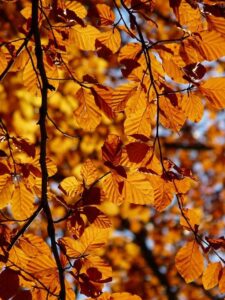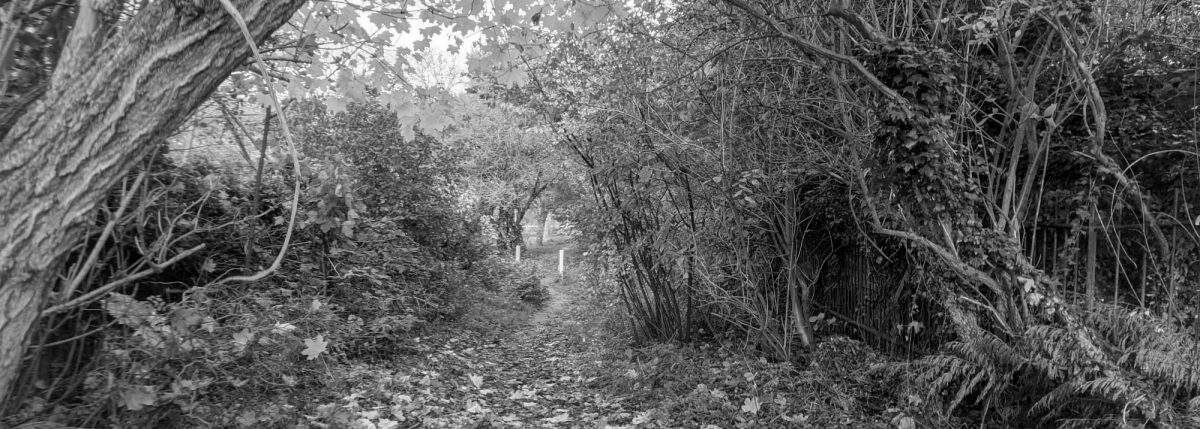Buds and Leaves
 Identifying winter twigs involves examining colour, shape and positioning of buds. An obvious example is the Ash tree which is easily identified by its distinctive black buds. With other species we need to decide whether there are terminal buds, single or multiple, and whether the other buds down the twig occur singly or in pairs. The Woodland Trust has information sheets which can be downloaded, intended to encourage children to get out and discover nature. Three useful simple sheets are Twig ID (18 species), Autumn Leaf ID (12 species), and Winter Tree ID (7 species). A more comprehensive booklet is produced by the Field Studies Council – Broad-leaved Trees and Shrubs in Winter – more than 50 pages of sketches and description of a wide range of species. There is another booklet on Winter Trees by Price & Bersweden which has photographs of 36 deciduous species showing twigs, bark, etc. There is also Kew’s elaborate guide to Identification of Trees and Shrubs in Winter using Buds and Twigs.
Identifying winter twigs involves examining colour, shape and positioning of buds. An obvious example is the Ash tree which is easily identified by its distinctive black buds. With other species we need to decide whether there are terminal buds, single or multiple, and whether the other buds down the twig occur singly or in pairs. The Woodland Trust has information sheets which can be downloaded, intended to encourage children to get out and discover nature. Three useful simple sheets are Twig ID (18 species), Autumn Leaf ID (12 species), and Winter Tree ID (7 species). A more comprehensive booklet is produced by the Field Studies Council – Broad-leaved Trees and Shrubs in Winter – more than 50 pages of sketches and description of a wide range of species. There is another booklet on Winter Trees by Price & Bersweden which has photographs of 36 deciduous species showing twigs, bark, etc. There is also Kew’s elaborate guide to Identification of Trees and Shrubs in Winter using Buds and Twigs.
Once the leaves start to appear with the approach of spring it is obvious that leaf shape varies with the tree species. Roughly based on the shape of a circle or ellipse of different sizes we have Hazel, Elm, (the leaves of these two species look very similar but Hazel’s are smooth and those of the Elm are rough like sandpaper), Lime, Goat Willow, Alder, Spindle, Apple, Hornbeam, Dogwood, Birch. Hawthorn and Midland Thorn both have leaves whose edges are indented (more deeply on the common Hawthorn), while Blackthorn and Buckthorn edges are either smooth or finely serrated. Both Wild Cherry and Bird Cherry have very finely toothed edges on oval leaves with the Wild Cherry leaf longer than that of the Bird Cherry. Horse Chestnut leaves are distinctive and have five to seven “fingers” – the buds are the equally familiar “sticky buds”. Sweet Chestnut leaves are long and glossy and have a toothed edge. Both Pedunculate (English) Oak and Sessile Oak have deeply indented edges but the English Oak leaf has no stalk (but the acorn hangs from a longish stalk or peduncle) and the Sessile Oak leaf hangs from a long stalk (and the acorn has virtually no stalk. i.e. It is sessile). Turkey Oak leaves are deeply lobed and the acorn cup is covered in many coarse hair-like growths. Holly and Laurel both have thick waxy leaves which are retained through the winter. Unlike most other trees the leaf stalk of the Ash divides into multiple opposite-paired leaflets (pinnate), as do the leaves of Rowan and Elder. Conifers have leaves which are reduced to a needle shape.
The above descriptions are rather vague so a good field guide is necessary to get an ID. Try Collins complete guide to British Trees (photographic) or the Collins Tree Guide which is based on artwork. Many trees tend to hybridise to some extent, e.g. Hawthorn and Midland Thorn, Silver Birch and Downy Birch, and have other trends which mix up the genetics, so the characteristics of an individual tree might not be “pure” and it might not be possible to be certain of the species identity.
by Ted Forsyth
